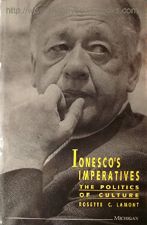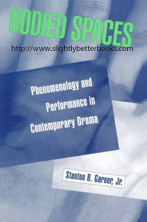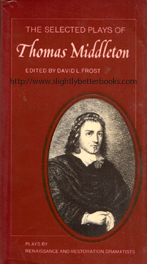

Slightly Better Books
Category Focus:Plays - playwrights
Books about particular playwrights and their works, methods, influences and impact
 |
Home | Contact | About Us |  |
|||||||||||||||||||||||||||||
|
|||||||||||||||||||||||||||||||||
| |
|||||||||||||||||||||||||||||||||
| Playwrights | ||
| In Pictures: | ****Hyperlinked titles will take you to our copy on sale or prebuilt searches of copies on sale****
Useful Links: Titles to Look Out For: |
On Amazon: |
 1993, University of Michigan Sorry, sold out, but click image above to access prebuilt search for this edition on Amazon Alternative online retailers to try: Click here to access our prebuilt search for this title on Alibris Click
here
|
Contents: The author links the modern idea of totalitarianism with the playwright's critique of language, thereby placing her discussion of his work within the new theoretical approaches to language and power. In moving the analysis of his work beyond the category of absurdist theatre, Lamont reveals how the power of his plays resides in his synthesis of the political, psychological, and metaphysical. Chapters: Conclusion: Ionesco and His Critics About the Author: |
�
Other Rosette Lamont books that may be of interest: |
 1994. Cornell University Press Sorry, sold out, but click image to access prebuilt search for this title on Amazon Alternative online retailers to try: Click here to access our prebuilt search for this title on Alibris
|
About the Book: In a venturesome study of corporeality and perception in contemporary drama, Stanton B. Garner, Jr. turns this awareness of the spectator's gaze back upon itself. His book takes up two of drama's most essential and elusive elements: spatiality, through which plays establish fields of visual and environmental relationship; and the human body, through which these fields are articulated. Within the spatial terms of theater, this book puts the body and its perceptual worlds back into performance theory. Garner's approach is phenomenological, emphasizing perception and experience in the theatrical environment. His discussion of the work of playwrights after 1950-including Samuel Beckett, Eugene Ionesco, Peter Weiss, Harold Pinter, Sam Shepard, David Mamet, Edward Bond, Maria Irene Fornes, Caryl Churchill, and Ntozake Shange-explores the body's modes of presence in contemporary drama. Drawing on work in areas as diverse as scenographic theory, medical phenomenology, contemporary linguistics, and feminist theories of the body, Garner addresses topics such as theatrical image, stage objects, dramatic language, the suffering body, and the staging of gender, all with a view toward developing a phenomenology of mise en scène About the author: At the time of publication Stanton B. Garner Jr. was Associate Professor of English at the University of Tennessee and was also author of The Absent Voice: Narrative Comprehension in the Theater Chapters: Chapter 1. Phenomenology and Performance Chapter 2. (Dis)figuring Space: Chapter 3. Object, Objectivity and the Phenomenal Chapter 4. The Performing "I": Language and the Histrionics of Place Chapter 5. Post-Brechtian Anatomies: The Politics of Embodiment Chapter 6. Female Landscapes: Phenomenology and Gender Afterword. Traces: The Dragon's Trilogy Bibliography; Index |
1994, hardback 1994, paperback |
 1978, Cambridge University Press, pbk In stock, click image above to buy for £5.00, not including post and packing, which is Amazon UK's standard charge of £2.80 for UK buyers Alternative online retailers to try: Click here to access our prebuilt search for this title on Alibris
|
About the series: This series was published to provide the best plays (and in some cases, the complete plays) of the major English Renaissance and Restoration dramatists, in fully-annotated, modern spelling texts, soundly edited by scholars in the field. Although the first three volumes are devoted to Renaissance dramatists, future volumes present the work of such Restoration playwrights as Etherege and Wycherley. The introductory matter in each volume is factual and historical rather than critical: it includes, where appropriate, a brief biography of the playwright, a list of his works with dates of plays' first performances, the reasons for the volume editor's choice of plays, a short critical bibliography and a note on the texts used. An introductory note to each play then gives the source material, a short stage-history, and details of the individual editions of that play. Facsimiles of the original or early title-pages are given. Annotation is of three types. Short notes at the foot of the page are designed to gloss the text or enlarge on its literary, historical or social allusions. At the end of the volume, in two separate appendices, editors have added more substantial explanatory notes and have commented on textual variants. The volumes are intended for anyone interested in English drama in two of its richest periods, but they will prove especially useful to students at all levels who want to enjoy and explore the best work of all these dramatists T. S. Eliot said of the Jacobean dramatist Thomas Middleton (1580-1627) that 'he wrote one tragedy which more than any other play except those of Shakespeare has a profound and permanent moral value and horror': Middleton has increasingly been recognized as one of the most important, if not the most important, Jacobean dramatist after Shakespeare himself. This volume contains 'The Changeling' (of which Eliot gave so high an estimate), together with Middleton's other surviving tragedy 'Women Beware Women', his best comedy 'A Chaste Maid in Cheapside', and a more light-hearted early play, 'A Mad World, My Masters'. Though Middleton is typical of many University-trained writers of the period who eked out a living in popular entertainment, his work has a cold, satiric stance, a grimly determinist flavour and a savage economy which make it unique. He wrote plays for the boys' companies in the early 1600s and later for Shakespeare's own company, The King's Men, but seems never to have established himself as more than a jobbing dramatist. The City of London gave him regular employment as a writer of civic entertainments and eventually made him City Chronologer, an office in which he died. Nevertheless, The Changeling was highly popular in its own day, and a political allegory, A Game at Chess, had the longest continuous run of any pre-Restoration play. Both 'A Mad World, My Masters' and 'The Changeling' were revived at the restoration, the latter with outstanding success. Similar success has accompanied the many modern revivals of 'A Chaste Maid', 'Women Beware Women', and 'The Changeling' by amateur and professional companies. The Royal Shakespeare Company (RSC) has twice presented 'Women Beware Women', and BBC Television gave 'The Changeling' a brilliant production as 'Play of the Month', in 1974 This volume builds on much recent scholarly work on Middleton's plays, and offers a text adapted to the needs of students and of actors. Each play has been edited from the early quartos, with full collation of all modern editions. Annotation (much of it new) is presented at the foot of each page: the editor has also included the items of prefatory material to the volume and to each play and the textual and additional notes which are standard features of the series |
Other Thomas Middleton Books |
|
[top] | |
| [top] | ||